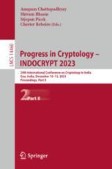Search
Search Results
-
Distributed Protocols for Oblivious Transfer and Polynomial Evaluation
A secure multiparty computation (MPC) allows several parties to compute a function over their inputs while kee** their inputs private. In its basic...
-
Unconditionally Secure Oblivious Polynomial Evaluation: A Survey and New Results
Oblivious polynomial evaluation (OPE) is a two-party protocol that allows a receiver, ℛ to learn an evaluation f ( α ), of a sender, 𝒮’s polynomial ( f ( x ...
-
Outsourcing Verifiable Distributed Oblivious Polynomial Evaluation from Threshold Cryptography
Distributed oblivious polynomial evaluation (DOPE) is a variant of two-party computation where a sender party...
-
Fair Distributed Oblivious Polynomial Evaluation via Bitcoin Deposits: Compute-as-a-Service
Distributed oblivious polynomial evaluation (DOPE) is a special case of two-party computation where the sender party...
-
MyOPE: Malicious SecuritY for Oblivious Polynomial Evaluation
Oblivious Polynomial Evaluation (OPE) schemes are interactive protocols between a sender with a private polynomial and a receiver with a private...
-
Homomorphic Polynomial Evaluation Using Galois Structure and Applications to BFV Bootstrap**
BGV and BFV are among the most widely used fully homomorphic encryption (FHE) schemes. Both schemes have a common plaintext space, with a rich...
-
Private Polynomial Commitments and Applications to MPC
Polynomial commitment schemes allow a prover to commit to a polynomial and later reveal the evaluation of the polynomial on an arbitrary point along...
-
Modular Polynomial Multiplication Using RSA/ECC Coprocessor
Modular polynomial multiplication is a core and costly operation of ideal lattice-based schemes. In the context of embedded devices, previous works...
-
Lattice-Based Polynomial Commitments: Towards Asymptotic and Concrete Efficiency
Polynomial commitments schemes are a powerful tool that enables one party to commit to a polynomial p of degree d , and prove that the committed...

-
Efficient Transparent Polynomial Commitments for zk-SNARKs
This paper proposes a new efficient transparent polynomial commitment scheme. In a polynomial commitment scheme, a prover commits a polynomial and a...
-
SLAP: Succinct Lattice-Based Polynomial Commitments from Standard Assumptions
Recent works on lattice-based extractable polynomial commitments can be grouped into two classes: (i) non-interactive constructions that stem from...
-
Exact subdomain and embedded interface polynomial integration in finite elements with planar cuts
The implementation of discontinuous functions occurs in many of today’s state-of-the-art partial differential equation solvers. However, in finite...

-
Polynomial Analysis of Modular Arithmetic
The modular polynomial abstract domain, MPAD, is proposed, whose invariants are systems of polynomial equations that hold modulo a power of 2. Its...
-
Polynomial XL: A Variant of the XL Algorithm Using Macaulay Matrices over Polynomial Rings
Solving a system of m multivariate quadratic equations in n variables over finite fields (the MQ problem) is one of the important problems in the...
-
Protein acetylation sites with complex-valued polynomial model
Protein acetylation refers to a process of adding acetyl groups (CH3CO-) to lysine residues on protein chains. As one of the most commonly used...
-
Algorithmic Views of Vectorized Polynomial Multipliers – NTRU
The lattice-based post-quantum cryptosystem NTRU is used by Google for protecting Google’s internal communication. In NTRU, polynomial multiplication...
-
Dew: A Transparent Constant-Sized Polynomial Commitment Scheme
We construct a polynomial commitment scheme with constant (i.e., independent of the degree) sized evaluation proofs and logarithmic (in the degree)...
-
Breaking SIDH in Polynomial Time
We show that we can break SIDH in (classical) polynomial time, even with a random starting curve...
-
ECC based novel color image encryption methodology using primitive polynomial
With the increasing use of digital images, there is a growing need for secure and efficient image encryption algorithms to ensure their...

